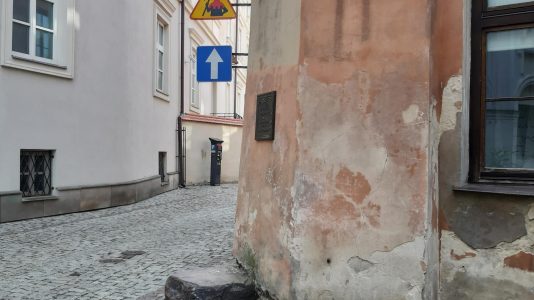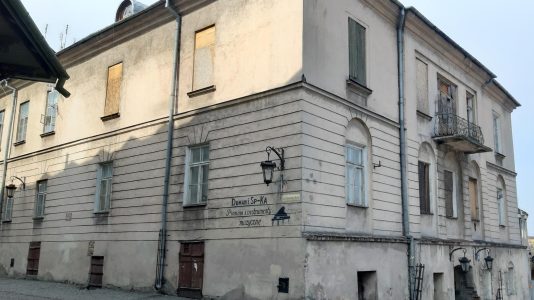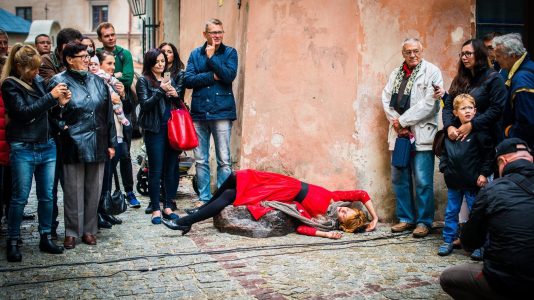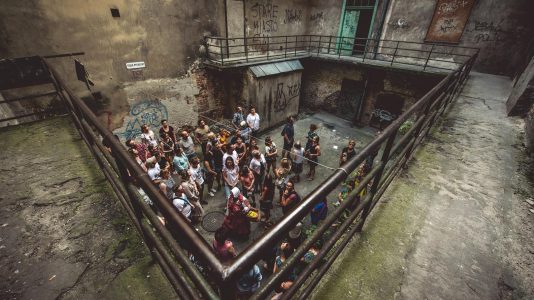Stone of misfortune
It is better not to touch this stone!
Over the years, Lublin has been affected by fires, plagues and many other misfortunes. And some stone was to blame for all or at least some of this. What is intersting, it is still in the city today!
One of Lublin’s curiosities is the stone of misfortune which the subject of a gruesome legend. Today, the stone – a true persecutor of the humankind – still rests on the corner of a quiet Jezuicka Street, grinning as if wanted all by-passers to see a scar left on its face by the executioner’s axe.
It is said to have come from Sławinek near Lublin. In the early 15th century, it “held duty” on Bernardyński Square, once an execution square, as a support to an oak trunk dripping with blood of condemned men. On one occasion, the executioner sheared off an innocent man’s head so ferociously that the trunk broke into two and the axe left a deep chip in the stone. Then someone rolled it over to the square on Rybna Street. One day, a woman was passing by with a double pot, carrying a good dinner for her husband working on a building site. Next to the stone, she tripped and fell, the pots breaking into pieces on top of the stone. The smell of the soup seasoned with fat attracted a few stray dogs which attacked the food ravenously, licked the stone thorougly and all dropped dead. The sight of the dead animals stirred a great sensation and the square was named Psia Górka (Dog’s Hill).
With the passing of time, people found out that by touching the stone with one’s hand or bare foot, a contact was established between the stone and the man, bringing bad luck on him. A baker could not resist having the stone and used it in the stove of his new bakery. Soon the man got burnt in the stove, locked in by his own wife and his journeyman who was making advances towards her.




The evil stone returned to Psia Górka and blinded a bricklayer who had struck it fiercely with a hammer. Soon afterwards, construction of the Trinitarian Church started, funded by Mikołaj Łoś of Grodków. After the walls were erected, people had an idea to roll the stone into the church and use it in the construction of the altar. It soon turned out that although the church building and the bell tower had been erected, the church would never be completed because of a shortage of funds to finish the interior. The church walls were bought several decades later by one Pawęczkowski who, having removed the stone, converted the building into a palace for himself which still stands on Psia Górka.
After the Orthodox Cathedral had been erected on Litewski Square, the stone of misfortune was placed next to and caused the death of a soldier who fell from the bell tower, crashing his skull on the surface of the malicious thing. Concerned about the integrity of the Cathedral in such a neighbourhood, the Russian authorities had the stone removed outside the town. When a power magazine was being built, it was somehow put in the foundations. As is well known, in 1919 the powder magazine blew up.
The stone remained in place for twenty years without any effect. Finally, it was put on the corner of Jezuicka Street, facing the Trinitarian Gate. When the war came, German pilots were flying over Lublin dropping bombs. And again the stone proved to be a curse, because most human casualties were reported in Jezuicka Street where it lay and around the Cathedral which it overlooked through the Trinitarian Gate. While the squadron was doing large circles, bombs were falling mainly within the operating radius of the stone of misfortune.
Today the stone, a true persecutor of the humankind, still rests on the corner of a quiet Jezuicka Street, grinning as if wanted all by-passers to see a scar left on its face by the executioner’s axe.
Do you need a professional city guide in Lublin? Check out our Guides of Inspiration and their tours!